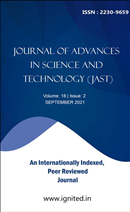A Study on Toxic Effects of Wastewater from Drain to Freshwater Fish Rohu
Main Article Content
Authors
Abstract
This study will explore the acute toxicity of untreated water from Labeo rohita in order to betterunderstand potential health risks. The CA divided the agglomerative hierarchy's four sample seasons intotwo clusters. Based on similarity and distance indices, CA determined that the water quality during therainy season (cluster I) was distinct from that of the other three seasons (cluster II). Three crucialcomponents for temporal water quality assessments were found using the PCAFA. The variables withthe largest factor loadings (>0.90), such as EC, TD, LP, TS, TDS, TSS, N, NH4-N, NO3-N, SO4-N, and Ni,have an impact on PC1, which explains 52.5 of the variation. PC2 accounts for 29.2 of the variationand includes Mg, AK, COD, OG, P, and Cd. According to PC3, pH, TH, and K account for 18.3 of thevariation. Minerals, organic, industrial, agricultural, and environmental contaminants that wereresponsible for the decline in drain water quality were found using PCAFA. On the basis of time andconcentration, scale morphological alterations were seen. Lepidontal breakage and uprooting,destructions at the bases of circuli and radii, complete structural loss in the focal area, neighbouringcirculi and radii, and changes in tubercle structure were also seen at the anterior and posterior regionsof scales.
Downloads
Download data is not yet available.
Article Details
Section
Articles
References
- Choudhury, B.H., Das, B.K. and Chutia, P. (2015): “Evaluation of pesticide residues in fish tissue samples collected from different markets of Jorhat district of Assam, India”. International Journal of Scientific & Engineering Research, 4(12): 2286 -99.
- Abdul Naveed, Janaiah, C. and Venkateshwarlu, P. (2015): “The effect of lihocin toxicity on protein metabolism of the freshwater edible fish, Channa punctatus (Bloch)”. Journal of Toxicology and Environmental Health Sciences, 3(1): 018-023.
- Abhilas, R. and Prakasam, V.R. (2015): “Toxic, physico-morphological and behavioural responses of Oreochromis mossambicus exposed to commercial grade endosulfan”. Environment Ecology, 54(2): 234-238.
- Baghat, M.I., El Kady, G.A., Temarek, S.A. and Lysandrou, M. (2017): “The natural Bio- Insecticide spinosad and its toxicity to combat some mosquito species in Ismaila Governorate Egypt”. World Journal of Agricultural Sciences, 3: 396-400.
- Das, B.K. and Mukherjee, S.C. (2018): “A histopathological study of carp (Labeo rohita) exposed to hexachlorocyclohexane”. Veterinarski Arch. 70(4): 169-180.
- Adhikari, S., Ghosh, L., Giri, B.S. and Ayyappan, S. (2019): “Distribution of metals in the food web of fishponds of Kolleru lake India”. Ecotoxicology and Environmental Safety, 72: 1242–1248.
- Benli, A.C.K., Koksal. G. and Ozkul, A. (2018): “Sublethal ammonia exposure of Nile tilapia (Oreochromis niloticus L.,). Effects on gill, liver and kidney histology”. Chemosphere, 72: 1355-1358.
- David, M., Mushigeri, S.B., Shivakumari, R. and Philip, G.H. (2016): “Response of Cyprinus carpio (Linn) to sublethal concentration of cypermethrin alteration in protein metabolic profile”. Chemosphere. 56(4): 347-352.
- Elzen, G.W. (2019): “Lethal and sublethal effects of insecticide residues on Orius insidiosus and Geocoris punctipes”. J. Econ. Entomol. 94: 55-59.
- Anita Susan, T. (2016): “Toxicity and effect of fenvalerate to the three Indian major carps Labeo rohita, Catla catla and Cirrhinus mrigala (Ham)”. Ph.D.Thesis submitted to Nagarjuna University, A.P., India.
- Cavaş, T. and Ergene-Gozukara, S. (2018): “Evaluation of the genotoxic potential of lambda-cyhalothrin using nuclear and nucleolar biomarkers on fish cells”. Mutat. Res. 534: 93-99.
- H.F. Dahi and Y.A. El-Sayed (2018): “Toxicological evaluation and biochemical impacts for radient as a new generation of spinisyn on Spodoptera littoralis larvae”. Egypt Acad. J. Biolg. Sci., 1(2): 85-97.
- Hackenberg, D. (2017): “Letter from David Hackenberg to American growers from March 14”. Plattform Imkerinnen-Austria.

